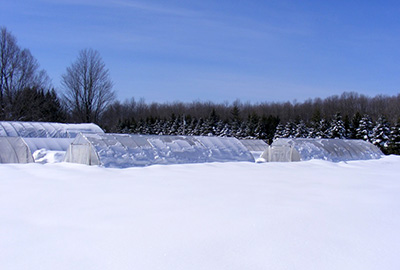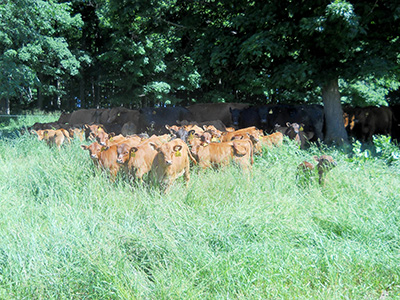Why farm in Michigan’s Upper Peninsula?
Low cost land and a laidback lifestyle may seem appealing, but the basics of successful farming in Michigan’s Upper Peninsula are the same as everywhere else: careful planning, efficient use of resources, adaptability, commitment and good luck.

Farms in Michigan’s Upper Peninsula often face many challenges. Over the years, Michigan State University Extension educators have worked with various types and sizes of farms to minimize these trials.
- The environment, weather, soil types and short growing seasons challenge successful farming here.
- The infrastructure serving Upper Peninsula farmers (businesses supplying seed, fertilizer, lime, equipment, repairs, etc.) is minimal and often distant. Distance to markets adds expense and complication to profitable agriculture production.
- The number of traditional farms is decreasing, but the overall number of Upper Peninsula farms is increasing due to an influx of small, diversified farms.
- Many farmers have few farming neighbors to work with and depend on.
- Numerous farms do not have an upcoming generation to take on the agricultural business and farmers themselves are aging.
- Relatively small fields and equipment make large-scale crop production difficult.
- Predators and vertebrate pests may be more numerous or damaging, but some insect pests and diseases are less common relative to other places.
At a first glance, some of these factors may appear similar to agriculture throughout Michigan. However, other elements are unique to the Upper Peninsula or especially prominent here, giving a special twist to farming in the Upper Peninsula, particularly our weather, soil and access to inputs and markets.

And the people…
Those who love farming in the Upper Peninsula are not necessarily natives of the area but must be determined to stay. There is a certain understanding among farmers who annually remove over 200 inches of snow out of the barnyard, either to let the milk truck in week after week, or just to get the livestock fed. This quiet pride among farmers may not be restricted to the Upper Peninsula, but there are some unique features.
For example, the calculated risk that barn roofs or the plastic on your hoop houses will hold up to the snow load, at least until you can get out with your snowblower to cut out the pile along the bottom. Or waiting for the snow to melt off the fields so you can get your small grains and hay seeding in by the second week of May. Or negotiating with the milk hauler to keep your isolated farm on the route. Or wading through permits to gain permission to remove sandhill cranes from your fields before they destroy your crops.
Every year, MSU Extension educators are contacted by people wanting to come to the Upper Peninsula to farm. Some are beginners, maybe dreamers, and others are experienced people looking for new opportunities. Here are a few of the things we tell them.
Land price for purchase or rent is relatively cheap, with rent for cropland around $20-$40 per acre in many areas. However, it is important to note that not all land in the Upper Peninsula is suitable for agricultural uses. Buyers should learn what the past or current land use has been for a particular property. A second option would be to use resources like the NRCS Web Soil Survey.
What will grow here?
- Forages are the backbone of Upper Peninsula agriculture. Primarily cool-season grasses such as orchardgrass, timothy, mixed hay, pasture and alfalfa in a few places.
- For commodity-type farms: corn (mostly for silage), small grains including oats, barley and wheat, potatoes and canola. Some of the areas with more moderate climate will support soybeans and dry beans.
- For smaller scale, local food producers: Cole crops or Brassicas, shorter season and cold hardy vegetables, root crops, sweet corn and with season extending hoop houses, just about anything.
What can I produce that will make money? Maybe cover the land costs? That’s really a tough question. This is where careful, realistic planning is a must. Do you have the finances, labor resources, willingness to assume risk, and dedication that it will take? The time-tested and proven sustainable farms, environmentally and economically, include:

- Dairy farms (although milk hauling access is becoming thin).
- Beef cow-calf farms (selling weaned feeder cattle).
- Beef farms (buying feeder calves and selling as larger feeder cattle, or grass finishing).
- Potato farms.
- Specialty fruit and vegetable farms. For example, U-pick strawberries and pumpkins or farmers market produce sales. Location near a major town is critical for success.
Showing promise in the area are small, diversified farms supplying smaller volumes of locally marketed produce, poultry and meat products. These farms often utilize hoop houses to extend the growing season and pasture for cost efficient livestock production. While few are certified as organic, many use organic production techniques. They are selling through farmers markets, community supported agriculture shares, on-farm stands and occasionally to restaurants and institutions. An Upper Peninsula food hub is under development to stimulate growth in this sector. Producers find that choosing livestock with genetics that can adapt to the harsh winters and can thrive with minimal outside inputs is key to their success.
Numerous small, part-time farms specialize in single commodities, such as horse hay or raising feeder pigs, even cold-tolerant fruit orchards.
If you’re interested in farming in Michigan’s Upper Peninsula, take a couple of weeks to tour the area. Visit the various pockets of agriculture in places such as Delta and Menominee counties, Bruce Crossing/Ontonagon, Western Alger County, Engadine/Germfask, Chippewa County and other places. Connect with local farmers, MSU Extension staff, local agriculture supply companies, veterinarians, U.S. Department of Agriculture staff and others. Learn everything you can. Then think it over – carefully.
Questions? Contact Michelle Sweeten at sweeten1@msu.edu or 765-346-8183 or James Dedecker, director of the MSU Upper Peninsula Research and Extension Center, at dedecke5@msu.edu or 906-439-5176.
For more information, see the related articles: A look at agriculture in Michigan’s Upper Penninsula, Farming in Upper Michigan: Where does food produced in the UP go?, and The U.P.’s Farming Revival.



 Print
Print Email
Email